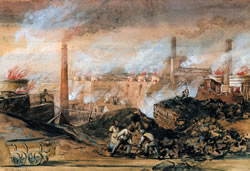Merthyr Tydfil Iron Industry
Merthyr Tydfil has built its history on a spirit of conquest. A Roman fort once stood proudly on what is now Merthyr Football Club's ground in the Penydarren area. Merthyr Tydfil takes its name from a local heroine. In AD 480, Wales was under threat as pagan Saxons pressed westwards across Britain. During this period Brychan, Prince of Brychaniog, was travelling through the area. His entourage was attacked and many members were murdered. Brychan's daughter, Tydfil, is said to have died as she prayed for help. Tydfil was later canonised and a church built on the spot where she is thought to have been murdered. The local settlement in which she was canonised was named Merthyr Tydfil.
Around 1158 the legendary Welsh Chieftain Ifor Bach, aggrieved at the appropriation of some land, led a group of men of Senghenydd into Cardiff Castle, kidnapping William Fitzcount, Lord of Glamorgan, his wife and son and keeping them until his stolen land was returned to him (with interest as compensation for the wrongdoing). In the Medieval period conflict occurred again in the area as the Norman Lords of Glamorgan and Brecon fought for control (The Battle of Maes Faenor) over what had become a strategic point. In 1286, Gilbert de Claire began to build a castle overlooking the area at Morlais. However, the castle was never completed. Edward I tired of the two Lords squabbling and so sent both of them to the Tower of London. Little remains of Morlais Castle, whose seven turrets once saluted the vales of Merthyr from its mountainous location.
The great mineral wealth of the valley was known from early days. A plate dated 1478 was found in the ruins of a small blast
furnace on the Taff riverbank near Abercanaid. Leases granted by the Earls of Pembroke and the Windsor family, who were large
landowners in the parish showed that people in the 16th century knew of the existence of this mineral wealth. Those who were
granted mineral leases laboured chiefly to supply their own domestic needs. For the making of iron, wood was used as the fuel, but
the work was done on such a small scale that the appearance of the district was initially not altered very much. Sussex ironmasters,
such as Anthony Morley, subsequently came into the Welsh valleys and were quick to exploit the local resources by establishing a
small works at Pontygwaith as early as 1583.

The Dowlais Iron Works which became the largest in the world, arose from very humble beginnings. The very first lease was purchased by Thomas Lewis in 1757 and a small primitive furnace was erected on ground adjacent to Dowlais Brook. Nearby water separated the earth from the ironstone and then the raw materials were transported to the furnace site for processing and smelting. The original enterprise was the result of nine ironmasters pooling their resources, but the turning point in the history of the works was the arrival of the future manager, John Guest.
Merthyr was soon to be recognised as 'the Iron Capital of the World', dominated by the four iron giants,
the Guest family ,the Crawshay dynasty which took
over and developed Francis Bacon's established Cyfartha Ironworks, the Homfray family which
built works in Penydarren and the Hill family who started the Plymouth works.